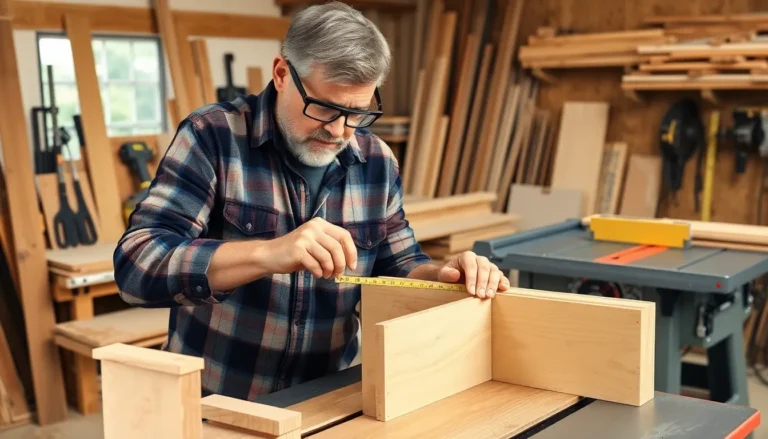Stepping into homeownership is like adopting a pet—exciting but a little terrifying. Suddenly, you’re responsible for everything from squeaky faucets to mysterious stains on the ceiling. Don’t panic! With a few handy tips, you can turn your new abode into a well-oiled machine instead of a chaotic sitcom episode.
Table of Contents
ToggleEssential Home Maintenance Tips for New Homeowners
Regular home inspections safeguard the structure’s integrity. Inspect the roof for missing shingles or leaks at least twice a year. Pay close attention to signs of water damage and mold.
Check gutters and downspouts for blockages. Clear debris every season to avoid water pooling near the foundation. Proper drainage extends the lifespan of the property.
Maintain HVAC systems for optimal performance. Schedule professional inspections annually to ensure efficiency. Change air filters every 1 to 3 months for better air quality.
Test smoke and carbon monoxide detectors monthly. Batteries should be replaced at least once a year. Keeping these devices functional ensures safety.
Inspect plumbing fixtures regularly for leaks. Look out for dripping faucets and running toilets, as they can waste significant water. Addressing these issues quickly minimizes utility bills.
Seal cracks and gaps in windows and doors to improve energy efficiency. Use caulk or weather stripping to prevent drafts. Homeowners save on heating and cooling costs this way.
Clean out the dryer vent to reduce fire hazards. A thorough cleaning twice a year helps maintain performance and safety. Lint buildup poses risks that homeowners can avoid with minimal effort.
Create a seasonal maintenance checklist to stay organized. Include tasks like changing smoke detector batteries, cleaning HVAC filters, or checking for pests. Following this plan promotes a well-maintained home environment.
Stay proactive with pest control by checking for signs regularly. Look for droppings, nests, or damage. Timely response protects against infestations.
Seasonal Maintenance Checklist

Regular seasonal maintenance ensures a home remains safe and efficient. New homeowners can benefit significantly from following a structured checklist throughout the year.
Spring Maintenance Tasks
Inspect the roof for any winter damage, ensuring all shingles are intact. Clean gutters to ensure proper drainage and prevent water buildup. Check the exterior for cracks in the foundation, and repair any gaps. Refresh garden beds by removing debris and adding mulch, which aids in moisture retention. Schedule a professional HVAC inspection to prepare for warmer months.
Summer Maintenance Tasks
Test the sprinkler system to confirm it operates correctly and adjust coverage areas. Trim overgrown trees and shrubs to prevent damage to the home. Check window screens for holes or tears; repair or replace as needed to keep pests out. Clean the outdoor furniture and grill to prepare for summer gatherings. Inspect the attic for signs of pests and insulation issues, as heat can exacerbate these problems.
Fall Maintenance Tasks
Clean gutters once more to prevent blockages from falling leaves. Examine windows and doors, checking for drafts and sealing gaps to enhance energy efficiency. Service the furnace to ensure readiness for the cold months ahead. Replace batteries in smoke and carbon monoxide detectors while ensuring all appliances function correctly. Start winterizing outdoor faucets by insulating or covering them.
Winter Maintenance Tasks
Monitor heating systems to ensure consistent warmth throughout the home. Inspect the attic for signs of moisture or ice dams, which can cause significant damage. Check for drafts around windows and doors, and add weather stripping as necessary. Keep pathways clear of snow and ice to prevent injury. Schedule a chimney cleaning if using a fireplace regularly to maintain safety and efficiency.
Interior Maintenance Tips
New homeowners should prioritize maintaining their interiors to ensure a comfortable living space. Implementing regular routines helps prevent large issues later.
Regular Cleaning Routines
Cleaning homes isn’t just about aesthetics; it impacts overall health. Dusting, vacuuming, and mopping floors once a week can keep allergens at bay. Scheduling deep cleans every season focuses on areas like carpets and upholstery. Regularly checking kitchen appliances and bathroom fixtures prevents buildup and maintains their function. Organizing storage spaces contributes to a more efficient home environment.
HVAC System Care
HVAC systems require regular attention to optimize performance. Scheduling professional inspections once a year ensures systems operate efficiently. Changing air filters every three months enhances air quality and extends system life. Checking for leaks around ducts prevents energy loss, saving money on utility bills. Homeowners benefit from keeping the outdoor unit clear of debris, which improves airflow and efficiency.
Exterior Maintenance Tips
Exterior maintenance is crucial for preserving a home’s condition and ensuring curb appeal. New homeowners benefit from staying proactive with regular upkeep.
Roof and Gutter Care
Inspecting the roof annually helps identify damage before leaks develop. Homeowners should focus on missing shingles or signs of wear and tear. Cleaning gutters twice a year prevents clogs that can lead to water damage. Debris accumulation may cause overflow, risking foundation issues. Checking downspouts for proper drainage is essential to redirect water away from the home.
Lawn and Landscape Maintenance
Regular lawn care encourages vibrant greenery and enhances overall aesthetics. Mowing the grass every week during growing season promotes healthy growth. Fertilizing the lawn several times a year supports strong root systems. Pruning shrubs and trees improves appearance and prevents overgrowth that can block walkways. Finally, planting seasonal flowers adds color while elevating mood, creating an inviting outdoor space.
Safety and Security Considerations
Ensuring safety and security in a new home is vital. Homeowners must install and maintain smoke and carbon monoxide detectors.
Smoke and Carbon Monoxide Detectors
Smoke detectors should be installed in every bedroom and hallway. Carbon monoxide detectors need placement near sleeping areas and on every floor. Testing these devices monthly is crucial for functionality. Replacing batteries annually can prevent malfunctions. Homeowners should also consider interconnected detectors, which trigger all alarms simultaneously when one detects smoke or carbon monoxide. According to the National Fire Protection Association, three out of five home fire deaths occur in properties without working smoke alarms. Staying informed about detector placement and maintenance dramatically enhances safety.
Home Security Systems
Investing in a home security system provides peace of mind. Homeowners can choose from various options, including alarm systems, surveillance cameras, and smart locks. Opting for a system that integrates with smartphones offers constant monitoring capabilities. According to statistics from the University of North Carolina, 60% of burglars avoid homes with security systems. Ensuring doors and windows are secured with quality locks adds another layer of protection. Installing motion-sensor lights around the property deters potential intruders. Setting up a comprehensive security strategy not only safeguards belongings but also fosters a sense of safety for all residents.
Embracing homeownership is a rewarding journey filled with responsibilities. By staying proactive with maintenance tasks and following the outlined tips, new homeowners can create a safe and comfortable environment. Regular inspections and seasonal checklists not only prevent costly repairs but also enhance the overall enjoyment of their space.
Investing time in both interior and exterior upkeep boosts curb appeal and ensures a welcoming atmosphere. Prioritizing safety measures further secures peace of mind. With these strategies in place, new homeowners can confidently navigate their responsibilities and truly make their house a home.



